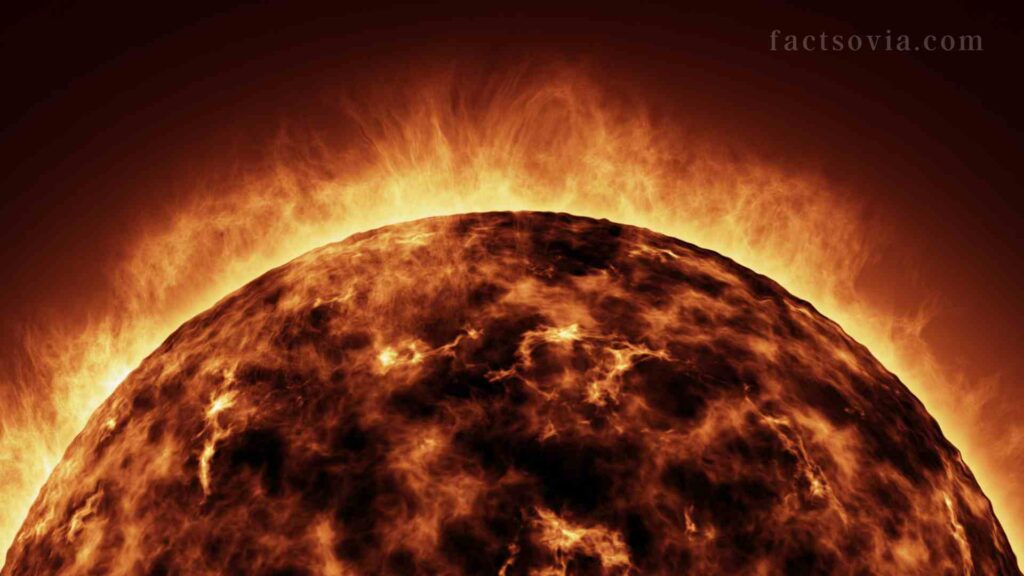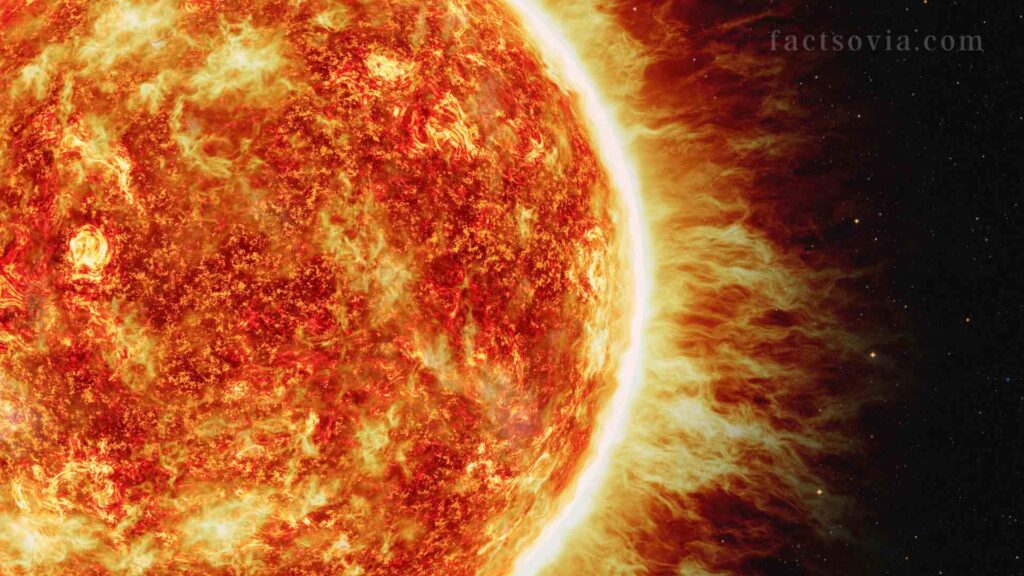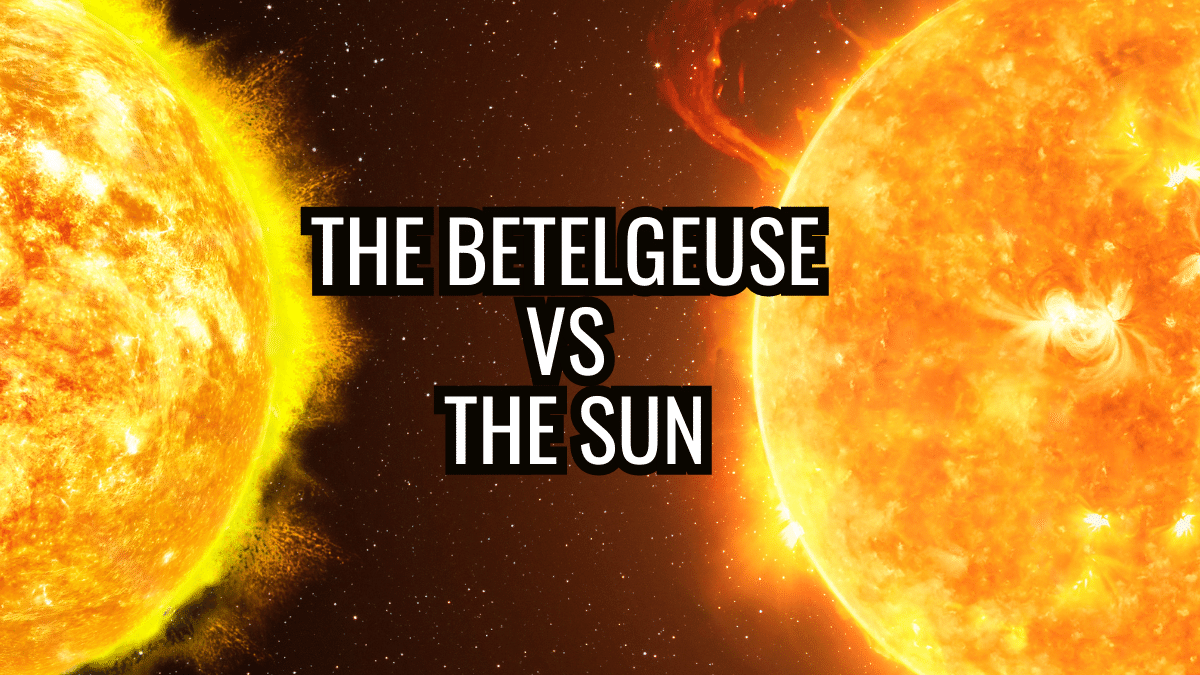We use affiliate links to run our site. When you buy through links on our site, we may earn an affiliate commission, without any added cost to you. Learn more
If you look up at the night sky, one star that will surely grab your attention is Betelgeuse, the big red-orange star that makes up Orion’s shoulder. Betelgeuse is a supergiant star, which means it’s incredibly vast and bright compared to most other stars. It’s one of the biggest and brightest stars we can see without a telescope from Earth!
Our Sun, on the other hand, is a normal yellow dwarf star about the middle size of stars. The Sun and Betelgeuse are both stars made of hot gas, but they actually have very little in common. Betelgeuse is old and nearing the end of its life after expanding to an enormous size. The Sun is still stable and has many more billions of years to go before it ages.
This article will compare these two famous but significantly different stars we can see in the sky. We’ll look at facts like their size, temperature, brightness, and life cycles to show how the colossal, cool Betelgeuse contrasts with our consistently hot Sun.
Learning about different kinds of stars helps us understand how stars are born, changed, and die throughout the universe.
Table of Contents
The Sun Vs The Betelgeuse
| Property | The Sun | Betelgeuse |
|---|---|---|
| Star type | Yellow dwarf star | Red supergiant star |
| Size | 1.4 million km diameter | 1.2 billion km diameter |
| Mass | 1 solar mass | ~20 solar masses |
| Surface temperature | 5,778K | 3,500K |
| Luminosity | 1 solar luminosity | ~100,000 solar luminosities |
| Color | White | Red-orange |
| Constellation | N/A – center of solar system | Orion |
| Distance from Earth | 150 million km | ~642 light years |
| Age | 4.6 billion years | 8-10 million years |
| Stage of life | Stable midlife as main sequence star | Nearing end of life |
| Fate | Will become red giant then white dwarf | Will likely explode in a supernova |
| Planets | Center of solar system with 8 planets | Unlikely to have planets |
Size:
One major difference between Betelgeuse and the Sun is the immense size of this supergiant star. With a radius over 1000 times larger than the Sun, if we replaced the Sun with Betelgeuse, its surface would extend past the orbit of Jupiter!
Red supergiant Betelgeuse has a radius of approximately 600 million kilometers. That’s compared to our Sun’s diameter of only 695,700 kilometers. Imagine the Sun as an orange next to Betelgeuse as a hot air balloon – that really puts their huge size difference into perspective!
Astronomers determined Betelgeuse’s size using stellar parallax from Earth’s orbit along with interferometry techniques. By studying slight changes in Betelgeuse’s position in the sky and using an array of telescopes to achieve higher resolution, the Hubble Space Telescope precisely measured the red supergiant’s diameter.
Betelgeuse does dwarf our Sun in size, but the two stars are more similar in mass. This supergiant tips the scales at 20 solar masses, meaning it’s about 20 times more massive than the Sun. Still, nowhere near as mind-blowing as Betelgeuse’s almost incomprehensible size.
Temperature:

In addition to its gigantic size, Betelgeuse’s distinctive reddish color makes it stand out against the blackness of space. However, this red supergiant Betelgeuse is relatively cool compared to the Sun’s blazing surface.
Betelgeuse has an average surface temperature of about 3500 K, while the Sun is much hotter at 5800 K. For context, a light bulb filament reaches up to 3000 K.
These temperature differences relate to the stars’ spectral types. Stellar classification is based on surface temperature, from hot O-type main sequence stars over 30,000 K down to cooler M-type red supergiants like Betelgeuse. Our Sun is a G-type yellow dwarf with a surface temperature in the middle of the stellar sequence.
Though its surface is cooler, Betelgeuse’s massive size enables huge energy output in the infrared spectrum. The Sun sustains consistently visible light emission during its stable years on the main sequence. But stars like this red supergiant Betelgeuse burn bright and hot – too vast and unstable to last long.
Luminosity:

When it comes to shining luminosity, Betelgeuse far outshines the more modest Sun. Its absolute magnitude is around -5.6, meaning Betelgeuse releases astronomical amounts of luminous energy across its span. In fact, this supergiant star has a luminosity nearly 100,000 times greater than our Sun!
Luminosity measures total stellar energy output. So while the Sun has a hotter surface, Betelgeuse emits far more light overall due to its gargantuan size.
If we could view it at the same distance as Earth is from the Sun, Betelgeuse would outshine our Sun an astonishing 15,000 times over! Thankfully, we observe this red supergiant from a safe 600 light years away.
Betelgeuse represents the class of the largest, most luminous supergiant stars late in their evolution. The Sun maintains consistent luminosity as a main sequence star.
Among the most luminous stars known are extremely huge, unstable supergiants millions of times more brilliant than our placid Sun.
Evolutionary Stage:
What explains the drastic differences between Betelgeuse and the Sun? It comes down to their vastly different stages of stellar evolution.
As a red supergiant, Betelgeuse is nearing the end of its life after evolving off the main sequence. This dying star has exhausted its core hydrogen fuel and expanded dramatically as a result.
Betelgeuse has likely already shed its outer atmosphere as a nebula, taking on an irregular shape. Fusion continues in its core and surrounding hydrogen shell for now, but the red supergiant Betelgeuse will meet its violent end in a supernova explosion.
On the other hand, our Sun is midway through its life at about 4.5 billion years old. It remains a stable main sequence star, sedately fusing hydrogen in its core – no dramatic changes ahead for billions of years.
The Sun will eventually turn into a red giant and then fade quietly away as a white dwarf, avoiding the spectacular supernova fate of more massive stars like the red supergiant Betelgeuse.
While Betelgeuse nears its death as an evolved supergiant, our Sun remains in its long stable adulthood. Stellar mass determines the life cycle, with massive stars like Betelgeuse burning hot and fast compared to lower-mass, long-lived stars like our Sun.
Similarities between The Sun and The Betelgeuse
Sun and Betelgeuse share the key traits common to all stars throughout the universe, as immense spheres of plasma undergoing nuclear reactions and emitting stellar radiation. In case you are thinking here are some of the similarities between The Sun and The Betelgeuse
Their similarities show how the physics of star formation and behavior applies universally across different stellar masses, fuels, sizes, and colors.
- Both are stars – immense balls of gas held together by gravity and undergoing nuclear fusion in their cores.
- Both are composed primarily of hydrogen and helium, with trace amounts of other elements.
- Both emit energy in the form of electromagnetic radiation across the spectrum.
- Both formed from collapsing clouds of interstellar gas and dust billions of years ago.
- Both have complex sunspot and magnetic activity on their surfaces.
- Both exhibit solar flares and ejections of solar material due to magnetic field interactions.
- Both have influence over orbiting bodies in their stellar systems via gravity.
- Both are classified within the main categories of the Hertzsprung-Russell diagram, a graph of star properties.
- Both have been critically important to advancing our understanding of stellar classifications, evolution, and lifecycles over the centuries.
- Both can be observed from Earth’s surface under the right conditions.
- Both have been photographed and studied via advanced telescopes and spectrographic techniques.
Final Thoughts:
The red supergiant Betelgeuse and our familiar Sun are two of the most famous stars, but share little in common. Supergiant Betelgeuse is a bloated red giant 1000x wider than the Sun, rapidly approaching its violent end.
Meanwhile, our Sun is contentedly midway through its stable multi-billion-year main sequence phase. Red supergiants like Betelgeuse live short, dramatic lives due to their high mass and luminosity. Lower mass stars like the Sun peacefully fuse hydrogen for 10 billion+ years.
Comparing Betelgeuse and the Sun gives insights into stellar properties and evolution. Though all stars start as protostars in nebular clouds, their life stories follow vastly different trajectories based on mass, luminosity, and stability.
Understanding the diversity of stars seen from Earth with telescopes like Hubble helps us measure cosmic distances and map the growth of galaxies across billions of years since the Big Bang.
Frequently Asked Questions:
How far away is Betelgeuse?
Betelgeuse is located approximately 642 light years from Earth. That equals about 600,000,000,000,000 miles (9.5×1014 km). Even though it is one of the brightest stars in the night sky, its great distance means we only see it as a pinpoint of light from our planet.
How old is Betelgeuse?
Betelgeuse is estimated to be around 8-10 million years old. In cosmic terms, this makes it a relatively young star. For comparison, our Sun is about 4.5 billion years old and is considered middle-aged by astronomical standards. As a supergiant, Betelgeuse has already rapidly burned through the hydrogen fuel in its core.
What color is Betelgeuse?
Betelgeuse appears visibly as a red-orange color when observed in the night sky. Its distinctive reddish tint indicates it is a cool star with a surface temperature of around 3500 Kelvin. This makes it a red supergiant star. Hotter stars take on more of a blueish-white color.
What is the radius of Betelgeuse?
Betelgeuse has an estimated radius of approximately 600 million kilometers (370 million miles). That’s about 870 times the radius of our Sun. If Betelgeuse were at the center of our solar system, its surface would extend past the orbit of Jupiter.
Does Betelgeuse have planets?
There are currently no confirmed planets orbiting Betelgeuse. As a supergiant star nearing the end of its life, Betelgeuse has likely already shed any planets it may have had earlier in its lifespan through its outward expansion.
How big is Betelgeuse compared to Earth?
Betelgeuse is astronomically larger than Earth. With a radius around 870 times greater than our Sun’s, it would take over 9 million Earths to fill the volume of Betelgeuse. If we place Earth and Betelgeuse side-by-side, our planet would look tiny in comparison.
Amazon and the Amazon logo are trademarks of Amazon.com, Inc, or its affiliates.
